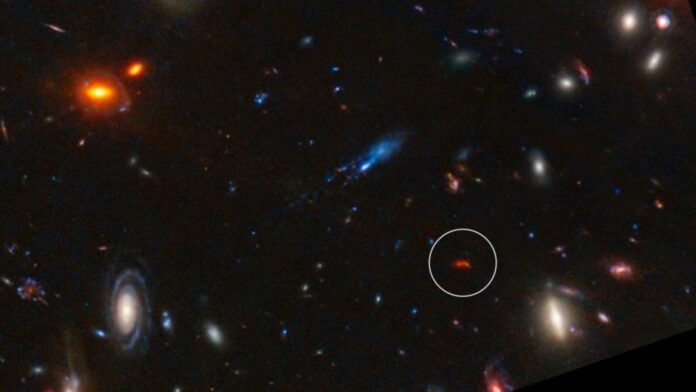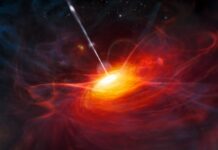Astronomers have identified an exceptionally active galaxy, designated Y1, that existed just 800 million years after the Big Bang. This galaxy is forming stars at a rate 180 times faster than the Milky Way, revealing a previously unknown era of intense starbirth in the early cosmos. The discovery offers critical insights into how galaxies rapidly evolved in the universe’s formative stages.
Unprecedented Star Formation
Y1’s extraordinary productivity was confirmed by measuring the temperature of its superheated cosmic dust using the Atacama Large Millimeter/submillimeter Array (ALMA). The light emitted by this primordial galaxy, traveling for 13 billion years, revealed a unique star-forming environment.
“We’re looking back to a time when the universe was making stars much faster than today,” explains team leader Tom Bakx of Chalmers University of Technology. Previous observations had already detected dust in Y1, making it the furthest galaxy with directly detected glowing dust. This led researchers to suspect an unusually efficient star factory.
The Puzzle of Early Dust
The research addresses a longstanding puzzle in cosmology: the abundance of dust in early galaxies. Conventional models struggle to explain how such young galaxies could accumulate significant dust reserves, as dust is primarily created by older, dying stars. The high temperature of Y1’s dust offers a potential resolution.
“Galaxies in the early universe seem too young for the amount of dust they contain,” notes Laura Sommovigo of the Flatiron Institute. “But a small amount of warm dust can appear as bright as large amounts of cool dust. That’s exactly what we’re seeing in Y1.”
This suggests that the apparent dust abundance may be an optical illusion—the result of hotter, brighter dust grains rather than sheer quantity.
The Conditions for Early Starbirth
Y1’s extreme star formation rate likely reflects the unique conditions of the early universe. At this epoch, galaxies were smaller, denser, and undergoing rapid growth. The intense starburst period, producing roughly 180 solar masses of stars annually, wouldn’t have lasted indefinitely. However, similar bursts may have been common in the early universe.
“We don’t know how common such phases might be,” Bakx adds. “But we plan to look for more examples of star factories like this.”
Implications for Galaxy Evolution
The discovery of Y1 reinforces the idea that the early universe was a period of chaotic, accelerated galaxy evolution. The intense star formation driven by environments like Y1 likely played a crucial role in seeding the universe with heavy elements and shaping the structures we observe today.
Further investigation using ALMA’s high-resolution capabilities will be essential to understand the detailed mechanisms driving Y1’s star formation. This includes identifying the sources of its extreme energy output and mapping the distribution of gas and dust within the galaxy.
The study of Y1 and similar star factories will continue to refine our understanding of the universe’s first galaxies and the conditions that allowed them to grow so rapidly



































